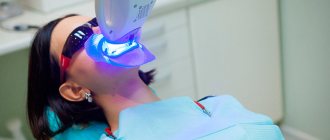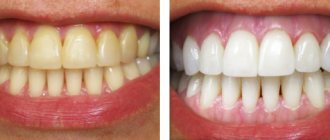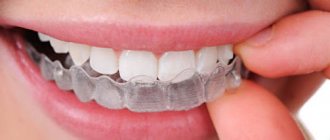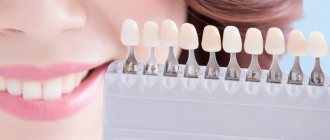Many people dream of a snow-white smile. However, the path to achieving this goal is different for everyone. Someone goes to a dental clinic and, after receiving advice from a specialized specialist, undergoes a professional teeth whitening procedure. And some believe that they can cope with the task on their own; to do this, they lighten their teeth at home using various publicly available means.
The first option will not have any negative consequences for health. The second option, on the contrary, can cause damage to the condition of the teeth, gums and oral cavity, as well as provoke the development of dental and other pathologies. The health hazards caused by self-lightening of tooth enamel will be discussed below.
What is in-office teeth whitening
In-office teeth whitening is an aesthetic dental procedure that takes place in a doctor’s office under his full supervision. An important advantage of this method over home whitening is absolute safety, fast and effective results. You can get the desired result even in one procedure, while teeth whitening at home will take several weeks. Anesthesia is not required, as there is no pain during the process.
What is real bleaching like?
Negative consequences of teeth whitening are possible if a whitening compound is applied to the crowns. It affects the structure of the enamel, destroys and washes out the yellow pigment. Before professional bleaching, it is necessary to carry out hygiene. Otherwise, the white color will “lay down” unevenly, which will look strange and unaesthetic.
To plan the final result of aesthetic therapy, dentists use a special scale. It is used to determine what tone the patient’s teeth have at the time of treatment (most often this is A3) and what he wants to have as a result of all medical procedures. Most people want to get shade A1 - it is the lightest on the scale.
Is it good? Striving for an unnatural white smile is not healthy. If your teeth are naturally yellow, you should not repeat the aesthetic treatment several times. It’s better to stop after lightening the enamel by several tones. Trying to get the smile of Hollywood stars can harm your own health.
Types of in-office whitening
Photobleaching
A gel is applied to the teeth, which is activated by light from a halogen or ultraviolet lamp. The gel contains peroxide, which decomposes into water and oxygen. It is thanks to the effect of oxygen that dark pigments from tooth tissue are discolored, creating a whitening effect.
Pros:
- high efficiency;
- quickly achieving the desired result;
- safety;
- painlessness.
Flaws:
- relatively high cost.
Chemical bleaching
The essence of the procedure is to apply two mixed gels to the surface of the teeth. As a result, a chemical reaction occurs that leads to discoloration of dark pigment spots in the dental tissues. The concentration of active substances is higher than with other types of whitening, which can cause a temporary increase in tooth sensitivity.
Pros:
- safety;
- high whitening speed.
Minuses:
- dental hypersensitivity is present for 1-2 days;
- the whiteness effect is not as pronounced as with photobleaching.
The Saint-Dent Clinic in Moscow provides all types of dental treatment. American and European equipment is used in their work; doctors have extensive experience and regularly improve their knowledge and skills through courses in the best foreign dental centers. You can find the clinic's contacts here. The section with current prices is posted here
Pastes with a whitening effect are the easiest option for improving the appearance of enamel
On sale you can find a huge number of special pastes, which contain abrasive and chemically active components. With regular use, they make teeth lighter and help get rid of unsightly yellow-gray plaque that appears due to:
- eating foods high in dyes;
- habits of drinking a lot of strong black tea and coffee;
- smoking;
- poor oral care.
But pastes cannot remove pigments located in the deep layers of enamel. They act superficially. Therefore, the result they provide will suit only people who do not strive for a Hollywood smile.
It is important to consider that bleaching hygiene products are highly abrasive. This means that they are ways to increase tooth sensitivity. For this reason, it is permissible to use them for short courses. It is prohibited to use them on an ongoing basis.
Advantages and disadvantages of the procedure
Advantages:
- achieving a good aesthetic result in just one session;
- with proper technological execution, the procedure is absolutely safe;
- within a week the patient will be able to return to their normal lifestyle.
Flaws:
- tooth sensitivity to hot and cold foods increases;
- there is a risk of thinning the enamel;
- the gums and mucous membrane of the tongue may become inflamed;
- in a few years the procedure will have to be repeated again.
Indications and contraindications
Indications:
- dark or severely discolored teeth;
- partial or complete internal darkening of teeth;
- presence of fluorous spots;
- age-related changes in tooth color.
Contraindications:
- numerous carious cavities;
- the presence of an exposed neck of the tooth;
- cracks and chips on the enamel surface;
- increased abrasion of enamel;
- enamel erosion or its partial absence;
- periodontal disease;
- allergic reactions to one of the components included in the gel;
- oral diseases.
It is important to know. Restorative materials and crowns cannot be bleached, so after completion of the procedure it is necessary to re-do the restoration. It can be performed no earlier than 2 weeks after in-office whitening.
AirFlow is not whitening
AirFlow is a technique that involves abrasively cleaning units. Some people think that it is aimed at lightening the enamel. In fact, this is not true. This is a standard hygiene procedure used to remove soft plaque and hardened tartar.
Since crowns are thoroughly cleaned during an AirFlow session, their appearance becomes much more aesthetically pleasing. However, there is no harm to oral health. Dentists recommend undergoing professional hygiene every year. This will keep your teeth and gums in good condition and reduce the likelihood of cavities forming.
The essence of the in-office whitening procedure
The dentist performs the following actions:
- applies protection to the oral mucosa;
- applies the whitening agent to the frontal area of the teeth;
- when photobleaching, I expose the gel to light from a halogen or ultraviolet lamp;
- after a certain time (on average 15 minutes), the drug is washed off with plenty of water;
- At the end of the procedure, the teeth are coated with a special gel that reduces their sensitivity.
Good to know. Along with the darkened areas of the teeth, useful minerals are removed. The lack of substances can be compensated for by remineralization of teeth.
Zoom 4 – safe whitening mechanism
Initially, using a special scale, the doctor determines the existing color shade of the tooth enamel. The next step is protective treatment of the oral cavity. Finally, the initial application of the whitening composition to the front teeth (5 upper and 5 lower) occurs. After this, a hardware targeted effect occurs on the treated teeth using a lamp that produces ultraviolet radiation for 10-15 minutes. The protective treatment of the soft tissues of the mouth mentioned earlier is intended for this purpose. Special glasses are used to protect the patient's eyes. Then the gel is applied two more times and the procedure is repeated. Thus, the time spent at the dentist is no more than one hour.
One session will allow you to enjoy a charming smile for more than one year, and, compared to the previous generation, with Zoom 4 the effect lasts up to 25 percent longer (up to 7 years, subject to strict adherence to the doctor’s recommendations).
How long does the procedure take?
While the patient is in the dental chair, the doctor constantly monitors his condition and the color of the teeth being whitened. One session consists of 1-3 whitening procedures of 15 minutes each. If during the session the patient experiences any unpleasant sensations, he must notify the specialist about this. If necessary, the procedure can be repeated after a few days.
How much can you whiten your teeth with this type of whitening?
Changes before and after in-office whitening will be noticeable immediately. After chemical whitening, teeth become lighter by 6-8 tones, and after photo-whitening – by 8-12 tones.
Other negative consequences
Independent and uncontrolled teeth whitening can lead to the development of serious diseases, as well as functional disorders of internal organs. For example, the entry into the general bloodstream of pathogenic microorganisms that cause diseases of the gum tissue can lead to the formation of blood clots with all the ensuing consequences. In this regard, disruptions in the functioning of blood vessels and the heart are common.
Some people make and use their own mouth rinses. This is also fraught with negative consequences. If the composition regularly enters the esophagus and stomach, even in microscopic doses, gastritis, ulcers and other diseases of the digestive system may develop.
In pursuit of a snow-white smile, people who are not aware of the consequences of carrying out a set of independent teeth whitening procedures expose their own health to unjustified risks. This often leads to irreversible damage to tooth enamel, oral mucosa, gums, and sometimes other organs. To whiten your teeth and avoid these consequences, contact only a qualified specialist. Take care of your health!
How long does the effect last and how often should the procedure be done?
The resulting effect lasts for 2-7 years. The duration of the result depends on the type of whitening chosen, the individual characteristics of the person and his lifestyle. Teeth whitening can be repeated at least after 1-2 years.
To ensure that the whitening effect lasts as long as possible, you must follow these recommendations:
- maintain oral hygiene;
- to refuse from bad habits;
- limit the consumption of coloring foods and drinks (you should completely avoid them in the first 7 days);
- Visit a hygienist every six months for professional oral cleaning.
Not everyone can whiten their teeth to the maximum: we explain why
There are categories of patients for whom the best method of teeth whitening is the installation of microprostheses (veneers, lumineers, ultraneers, nanoeers) and crowns. Or, just a complex of professional hygiene. The fact is that traditional whitening methods are not suitable for them due to contraindications, for example, with severe fluorosis and hypoplasia, wedge-shaped defect, extensive destruction of hard tissues, increased abrasion of enamel and multiple caries.
“Since childhood, all my teeth were stained, but I really wanted a smile like the Hollywood actors have - just as white and shiny. I really counted on teeth whitening in this regard, but the doctors disappointed me... They said that in the face of a form of fluorosis like mine, none of the methods would help. They offered veneers. I thought for a long time. In the end I decided... I haven’t regretted it yet. It’s convenient that your teeth are protected, and you don’t feel any discomfort at all, which is something you can’t boast about after whitening. And the color of the overlays is always normal, no matter what I eat.”
Larinova F, review from the dental portal gidpozubam
If you have fluorosis, teeth whitening will not be effective.
According to some studies, no professional, or even more so non-professional, whitening methods will be able to maximally change the shade of enamel for people whose natural color is not yellowish, but gray.
If you already have fillings and dentures in your smile area, then it is also important to understand that they cannot be whitened. Any method known today affects only living tissue, but artificial materials remain unchanged. Therefore, after the procedure, you will have to change the restorations to new ones so that there is no discoloration.











